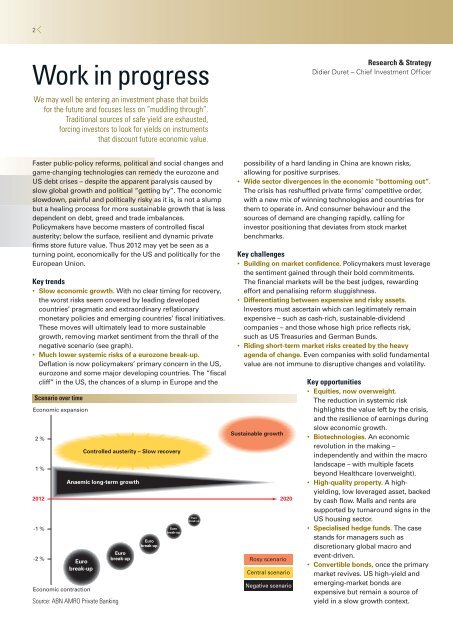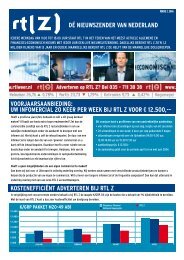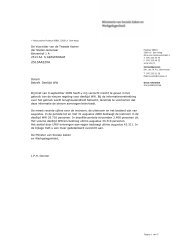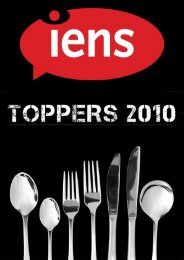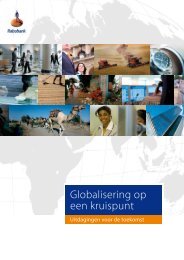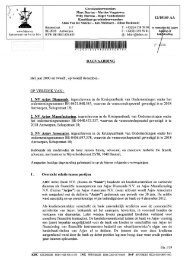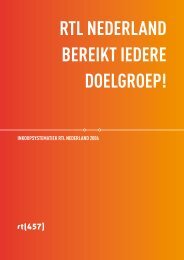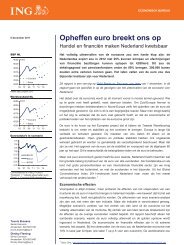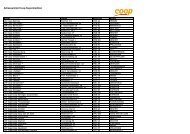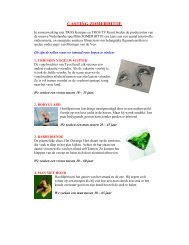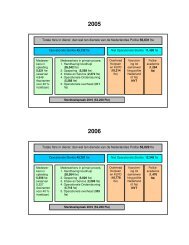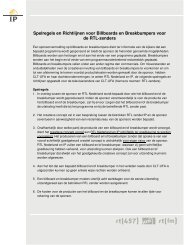Didier Duret - RTL.nl
Didier Duret - RTL.nl
Didier Duret - RTL.nl
You also want an ePaper? Increase the reach of your titles
YUMPU automatically turns print PDFs into web optimized ePapers that Google loves.
2<br />
Work in progress<br />
We may well be entering an investment phase that builds<br />
for the future and focuses less on “muddling through”.<br />
Traditional sources of safe yield are exhausted,<br />
forcing investors to look for yields on instruments<br />
that discount future economic value.<br />
Faster public-policy reforms, political and social changes and<br />
game-changing technologies can remedy the eurozone and<br />
US debt crises – despite the apparent paralysis caused by<br />
slow global growth and political “getting by”. The economic<br />
slowdown, painful and politically risky as it is, is not a slump<br />
but a healing process for more sustainable growth that is less<br />
dependent on debt, greed and trade imbalances.<br />
Policymakers have become masters of controlled fiscal<br />
austerity; below the surface, resilient and dynamic private<br />
firms store future value. Thus 2012 may yet be seen as a<br />
turning point, economically for the US and politically for the<br />
European Union.<br />
Key trends<br />
• Slow economic growth. With no clear timing for recovery,<br />
the worst risks seem covered by leading developed<br />
countries’ pragmatic and extraordinary reflationary<br />
monetary policies and emerging countries’ fiscal initiatives.<br />
These moves will ultimately lead to more sustainable<br />
growth, removing market sentiment from the thrall of the<br />
negative scenario (see graph).<br />
• Much lower systemic risks of a eurozone break-up.<br />
Deflation is now policymakers’ primary concern in the US,<br />
eurozone and some major developing countries. The “fiscal<br />
cliff” in the US, the chances of a slump in Europe and the<br />
Scenario over time<br />
Economic expansion<br />
2 %<br />
1 %<br />
2012<br />
-1 %<br />
-2 %<br />
Anaemic long-term growth<br />
Euro<br />
break-up<br />
Economic contraction<br />
Source: ABN AMRO Private Banking<br />
Controlled austerity – Slow recovery<br />
Euro<br />
break -up<br />
Euro<br />
break- up<br />
Euro<br />
break- up<br />
Euro<br />
break- up<br />
Research & Strategy<br />
<strong>Didier</strong> <strong>Duret</strong> – Chief Investment Officer<br />
possibility of a hard landing in China are known risks,<br />
allowing for positive surprises.<br />
• Wide sector divergences in the economic “bottoming out”.<br />
The crisis has reshuffled private firms’ competitive order,<br />
with a new mix of winning technologies and countries for<br />
them to operate in. And consumer behaviour and the<br />
sources of demand are changing rapidly, calling for<br />
investor positioning that deviates from stock market<br />
benchmarks.<br />
Key challenges<br />
• Building on market confidence. Policymakers must leverage<br />
the sentiment gained through their bold commitments.<br />
The financial markets will be the best judges, rewarding<br />
effort and penalising reform sluggishness.<br />
• Differentiating between expensive and risky assets.<br />
Investors must ascertain which can legitimately remain<br />
expensive – such as cash-rich, sustainable-dividend<br />
companies – and those whose high price reflects risk,<br />
such as US Treasuries and German Bunds.<br />
• Riding short-term market risks created by the heavy<br />
agenda of change. Even companies with solid fundamental<br />
value are not immune to disruptive changes and volatility.<br />
Sustainable growth<br />
2020<br />
Rosy scenario<br />
Central scenario<br />
Negative scenario<br />
Key opportunities<br />
• Equities, now overweight.<br />
The reduction in systemic risk<br />
highlights the value left by the crisis,<br />
and the resilience of earnings during<br />
slow economic growth.<br />
• Biotechnologies. An economic<br />
revolution in the making –<br />
independently and within the macro<br />
landscape – with multiple facets<br />
beyond Healthcare (overweight).<br />
• High-quality property. A highyielding,<br />
low leveraged asset, backed<br />
by cash flow. Malls and rents are<br />
supported by turnaround signs in the<br />
US housing sector.<br />
• Specialised hedge funds. The case<br />
stands for managers such as<br />
discretionary global macro and<br />
event-driven.<br />
• Convertible bonds, once the primary<br />
market revives. US high-yield and<br />
emerging-market bonds are<br />
expensive but remain a source of<br />
yield in a slow growth context.


